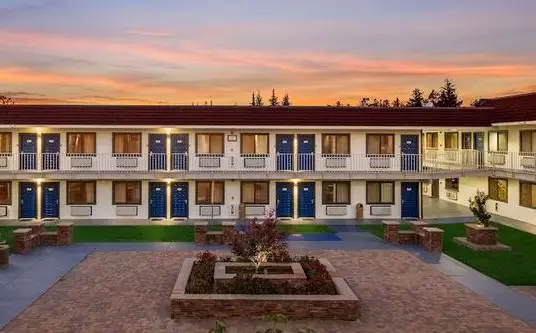
The state’s Homekey program helps reduce regulatory barriers to create shelter for the homeless.
Photo by fremont.gov
California added more than 6,000 shelter units for people experiencing homelessness in the first year of the COVID-19 pandemic. This was accomplished with a lot of pandemic relief money to buy and renovate hotels and motels; but much of the success is also due to a state program that reduced regulatory barriers to new shelters.
A new report from the Terner Institute for Housing Innovation shows that California’s Homekey program waives many local land use and planning requirements. This not only speeds up the purchase and renovation process, it also lowers the cost of creating new shelter space.
California has the nation’s largest population of unsheltered homeless persons. Unsheltered homeless people are at high risk of contracting COVID-19. Providing safe shelter not only protects people experiencing homelessness, but also slows the spread of the coronavirus throughout the community.
In July, 2020, the California legislature created the Homekey program. The legislature decided to use $800 million of the state’s federal pandemic relief funds to create thousands of shelter units quickly. As the program began showing success, the legislature approved a second round of $2.75 billion in July, 2021.
Homekey funds can be used to buy underused buildings and convert them to temporary shelter or permanent supportive housing. Although most of the buildings acquired have been hotels and motels, other types of buildings like single-family homes, apartment complexes, and manufactured housing can also be purchased.
The funds go to city and county governments, as well as Public Housing Agencies and nonprofit organizations. Homekey funds can also be used to support operations and services at the properties for two years.
From July through December, 2020 — just six months — Homekey supported the purchase and renovation of 94 properties with more than 6,000 shelter beds. This is an incredible achievement, given that California only produced about 10,000 new shelter beds over the previous four years combined.
The majority of these properties were converted to permanent supportive housing or have a plan to convert to supportive housing later on. People prefer permanent supportive housing because it has private rooms and supportive services.
The Homekey program also waived many local development requirements to speed up the creation of new shelters. According to the Terner Institute for Housing Innovation, Homekey’s reduction of regulatory barriers was one of the biggest factors in its success.
Homekey projects are exempt from California Environmental Quality Act requirements. Because the new use as shelters is not that different from the old use as hotels or motels, the projects could bypass the state’s environmental review requirements. Homekey also included several other provisions that reduced documentation requirements and streamlined the local approval process.
Regulatory issues in other areas
Meanwhile, in states like New York, new shelter development has stalled in part because of time-consuming and costly local building requirements.
Although the New York state legislature authorized a hotel conversion program similar to California’s, it has not had as much success. The main difference between the states is that New York’s legislation did not have any waivers of local land use, planning, or development requirements.
Nonprofit organizations in New York City expressed interest in using the program, but have often been blocked by the high cost and slow pace of local regulatory requirements. They have also faced more ‘Not in My Back Yard’ (NIMBY) opposition in the process.
This has left New York City still sitting on a large pot of funds for new shelters. The state legislature is looking to fix this problem with new legislation that will streamline parts of the approval process.
This is happening while New York City mayor Eric Adams has ordered sweeps of homeless persons in the subway system, and has also ordered sweeps of homeless street encampments. The mayor plans to clear 150 encampments in a period of two weeks.
Mayor Adams said that residents of the encampments will be offered shelter and services. Few people dislocated by the subway sweeps accepted services right away, although the numbers have grown.
Advocates for people experiencing homelessness are concerned that there is nowhere for many unsheltered people to go. The mayor’s subway plan announced the city would create 500 new shelter beds. In announcing the sweep of encampments, Mayor Adams said that 350 new beds had already been added. But there are thousands of New York City residents living without shelter.
The city even has a new web page instructing residents to call the police on homeless people sleeping in public. It instructs residents to report encampments, people sleeping in parks, or people sleeping on the streets to police.
The affordable housing crisis is caused by two things. Wages are too low, and there is not enough affordable housing for everyone that needs it. This is even more true after two years of economic hardships during the pandemic.
What more can be done?
Recognizing that the affordable housing crisis affects the whole country, President Biden specifically targeted regulatory barriers to affordable housing in his FY 2023 budget. The president has proposed $10 billion for activities that remove zoning and other local code barriers to new rental housing development.
More affordable housing is needed, and building it quickly is crucial. Reducing regulatory barriers can bring affordable housing to thousands of low-income renters in years instead of decades.
